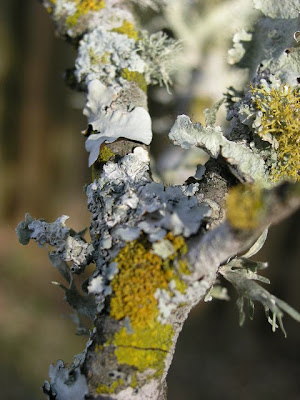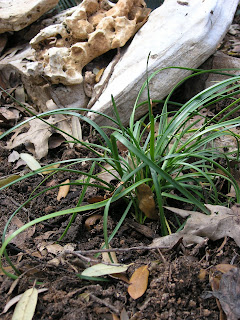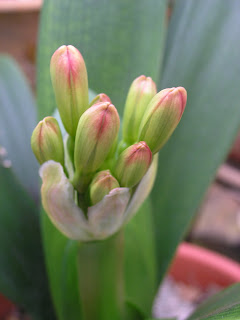Every time we place shovel, spade, trowel, pitchfork or even hand into the depths of our soil, we are likely to discover something...unanticipated. Over the last week, as I amended the dirt, dug the holes and planted the plants, I came across objects both expected and unexpected.
There is always, of course, the distinctive sound of metal hitting stone that lets one know that digging a hole in this particular location is not going to be quick nor will it be easy. Especially if the sound repeats itself as one tries a foot or so in all compass directions. Sometimes the limestone wins. And sometimes one can apply those old high school physics lessons regarding the power of the lever (i.e dangling oneself from the end of a rock bar) and actually pry out enough chunks to break through to the greater depths of soil beneath. Then the gardener has not only a location for the desired plant, but some rock to show off elsewhere (if one still has the energy to drag the darn stone there).
Or perhaps the digging utensil locates another solid object, but one with a duller "thud" to its resonance. Fortunately, a large tree root can usually be dodged by simply moving a half foot away along the perpendicular. But sometimes we discover the remains of a long departed tree, likely lost years before the land was ever divided up and sold as lots. The fragmented and decaying trunk remains, buried under consecutive layers of leaf litter and evolving soil, only now unearthed and soon to be added to the garden as an interesting flavor of "driftwood".
The soil is also often littered with fragments from the greater stones: small rocks and pebbles that can easily be removed. But sometimes, amongst these lesser pieces, if one is watching and not fooled by the layers of grime adhering to its surface, a real treat may be found. Crystals of quartz (or other minerals), once washed, will sparkle in the light.
Of course, there are also the man-made objects which we ourselves have placed into the soil and then forgotten, if not their existence, at least their location. These are the items which, if not discovered in time, often end up causing us grief. "Oh, so that 'thunk' was my garden pitchfork precisely impacting the underground pipe of my sprinkler system. And look, isn't that small hole in the dead center so cute. I've always wanted a fifteen foot geyser to erupt in this precise location each time I water my plants." And thus gardening leads to plumbing.
We gardeners abhor a blank spot, to our eyes it cries out for a stunning shade of green or a vibrant flash of color. Into the dirt we go, preparing it for that exact plant we have carefully selected for just this location. But what is this...why, it appears to be some type of bulb or underground rhizome. Strange, I didn't recall having planted anything in this particular spot. This whole dormancy thing can be quite confusing. Looks like I'm going to have to dig another hole for this little fella...I wonder what it could be. Hope this doesn't start a whole chain reaction of digging and bulb discoveries and more digging and more discoveries and so forth and so on...
As we gardeners delve into the ground, disturbing both soil and leaf litter, we occasionally find...life! Certainly ants will get one's attention and test one's reaction time. And there's those grubs that elicit our grumblings (though I'm sure they are absent from your garden). But my favorite has to be the pupa - one of the most amazing transitions found in the animal kingdom. That quiet stage that exists between what was and what will be; a door not yet opened. What will emerge from this plain brown-wrapped package? Will I later marvel at its beauty as it flits about from flower to flower? These are the types of surprises I enjoy quite a bit.
I wonder what I'll find in the dirt tomorrow...right after I repair the sprinkler pipe.
Of course, there are also the man-made objects which we ourselves have placed into the soil and then forgotten, if not their existence, at least their location. These are the items which, if not discovered in time, often end up causing us grief. "Oh, so that 'thunk' was my garden pitchfork precisely impacting the underground pipe of my sprinkler system. And look, isn't that small hole in the dead center so cute. I've always wanted a fifteen foot geyser to erupt in this precise location each time I water my plants." And thus gardening leads to plumbing.
We gardeners abhor a blank spot, to our eyes it cries out for a stunning shade of green or a vibrant flash of color. Into the dirt we go, preparing it for that exact plant we have carefully selected for just this location. But what is this...why, it appears to be some type of bulb or underground rhizome. Strange, I didn't recall having planted anything in this particular spot. This whole dormancy thing can be quite confusing. Looks like I'm going to have to dig another hole for this little fella...I wonder what it could be. Hope this doesn't start a whole chain reaction of digging and bulb discoveries and more digging and more discoveries and so forth and so on...
As we gardeners delve into the ground, disturbing both soil and leaf litter, we occasionally find...life! Certainly ants will get one's attention and test one's reaction time. And there's those grubs that elicit our grumblings (though I'm sure they are absent from your garden). But my favorite has to be the pupa - one of the most amazing transitions found in the animal kingdom. That quiet stage that exists between what was and what will be; a door not yet opened. What will emerge from this plain brown-wrapped package? Will I later marvel at its beauty as it flits about from flower to flower? These are the types of surprises I enjoy quite a bit.
I wonder what I'll find in the dirt tomorrow...right after I repair the sprinkler pipe.

















































